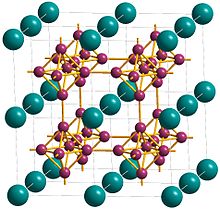
| |
| Names | |
|---|---|
| Other names strontium hexaboride | |
| Identifiers | |
| CAS Number | |
| 3D model (JSmol) | |
| ECHA InfoCard | 100.031.778 |
| EC Number |
|
| PubChem CID | |
| CompTox Dashboard (EPA) | |
InChI
| |
SMILES
| |
| Properties | |
| Chemical formula | SrB6 |
| Molar mass | 152.49 g/mol |
| Appearance | black crystalline powder |
| Density | 3.39 g/cm, solid (15.0°C) |
| Melting point | 2,235 °C (4,055 °F; 2,508 K) |
| Solubility in water | insoluble |
| Structure | |
| Crystal structure | Cubic |
| Space group | Pm3m ; Oh |
| Hazards | |
| NFPA 704 (fire diamond) |
 |
| Except where otherwise noted, data are given for materials in their standard state (at 25 °C , 100 kPa).
| |
Strontium boride (SrB6) is an inorganic compound. At room temperature, it appears as a crystalline black powder. Closer examination reveals slightly translucent dark red crystals capable of scratching quartz. It is very stable and has a high melting point and density. Although not thought to be toxic, it is an irritant to the skin, eyes, and respiratory tract.
Magnetism
Strontium boride, along with other alkali-earth metal borides, has been shown to exhibit weak ferromagnetism at low temperatures. This is thought by some to be caused by slight impurities or aberrations in the crystal lattice, while others suggest different explanations are needed. Strontium boride has also been examined for semiconducting properties at lower temperatures.
Preparation
In his book The Electric Furnace, Henri Moissan describes an early synthesis of strontium boride by mixing strontium borate, aluminum, and carbon in an electric furnace. Alternatively, a solid-phase synthesis of strontium boride can be carried out by reacting two moles of strontium carbonate with three moles of boron carbide and one mole of carbon inside a vacuum furnace.
Uses
Strontium boride is used in insulation and nuclear control rods. A recent patent filed for aircraft windows uses SrB6 nanoparticles in a transparent acrylic sheet. The IR-absorbing properties of these nanoparticles prevents the transmittance of infrared wavelengths while still allowing the transmittance of visible light.
References
- ^ "Archived copy" (PDF). Archived from the original (PDF) on 2006-02-09. Retrieved 2009-05-01.
{{cite web}}: CS1 maint: archived copy as title (link) - ^ Moissan, Henri. The Electric Furnace.
- Young, D. P.; Hall, D.; Torelli, M. E.; Fisk, Z.; Sarrao, J. L.; Thompson, J. D.; Ott, H. R.; Oseroff, S. B.; Goodrich, R. G.; Zysler, R. (1999). "High-temperature weak ferromagnetism in a low-density free-electron gas". Nature. 397 (6718): 412–414. Bibcode:1999Natur.397..412Y. doi:10.1038/17081. PMID 29667965. S2CID 204991033.
- Shang, S.; Liu, Z. (2007). "Thermodynamics of the B–Ca, B–Sr, and B–Ba systems: Applications for the fabrications of CaB6, SrB6, and BaB6 thin films". Applied Physics Letters. 90 (9): 091914. Bibcode:2007ApPhL..90i1914S. doi:10.1063/1.2710081.
- Gavilano, J. L.; Ambrosini, B.; Ott, H. R.; Young, D. P.; Fisk, Z. (2000). "Low-temperature NMR studies of SrB6". Physica B: Condensed Matter. 281: 428–429. Bibcode:2000PhyB..281..428G. doi:10.1016/S0921-4526(99)01197-7. S2CID 120195543.
- Dorneles, L.; Venkatesan, M.; Moliner, M.; Lunney, J.; Coey, J. (2004). "Magnetism in thin films of CaB6 and SrB6". Applied Physics Letters. 85 (26): 6377–6379. Bibcode:2004ApPhL..85.6377D. doi:10.1063/1.1840113. hdl:2262/31468.
- Ott, H. R.; Chernikov, M.; Felder, E.; Degiorgi, L.; Moshopoulou, E. G.; Sarrao, J. L.; Fisk, Z. (1997). "Structure and low temperature properties of SrB6". Z. Phys. B. 102 (3): 337–345. Bibcode:1997ZPhyB.102..337O. doi:10.1007/s002570050297. S2CID 123679160.
- ^ Zheng, Shu-Qi; Zou, Zeng-Da; Min, Guang-Hui; Yu, Hua-Shun; Han, Jian-De; Wang, Wei-Ti. "Synthesis of strontium hexaboride powder by the reaction of strontium carbonate with boron carbide and carbon". Journal of Materials Science Letters. 2002 (21): 313–315.
- "United States Patent Application 20090093578". Archived from the original on 2019-09-12. Retrieved 2009-05-05.
| Strontium compounds | |
|---|---|
| Borides Bx | ||||||||||||||||||||||||||||||||||||||||||||||||||||||||||||||||||||||||||||||||||||||||||||||||||||||||||||||||||||||||||||||||||||||||||||||||||||||||||||||||||||
|---|---|---|---|---|---|---|---|---|---|---|---|---|---|---|---|---|---|---|---|---|---|---|---|---|---|---|---|---|---|---|---|---|---|---|---|---|---|---|---|---|---|---|---|---|---|---|---|---|---|---|---|---|---|---|---|---|---|---|---|---|---|---|---|---|---|---|---|---|---|---|---|---|---|---|---|---|---|---|---|---|---|---|---|---|---|---|---|---|---|---|---|---|---|---|---|---|---|---|---|---|---|---|---|---|---|---|---|---|---|---|---|---|---|---|---|---|---|---|---|---|---|---|---|---|---|---|---|---|---|---|---|---|---|---|---|---|---|---|---|---|---|---|---|---|---|---|---|---|---|---|---|---|---|---|---|---|---|---|---|---|---|---|---|---|
| ||||||||||||||||||||||||||||||||||||||||||||||||||||||||||||||||||||||||||||||||||||||||||||||||||||||||||||||||||||||||||||||||||||||||||||||||||||||||||||||||||||